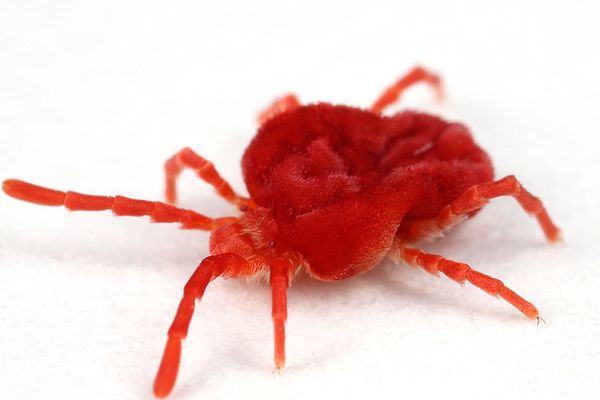- Red mites, also known as Tetranychus urticae, are one of the most common problems in cannabis crops, particularly in hot, dry climates.
- These mites are really fond of marijuana plants and are well capable of destroying your whole crop if they are not detected early and treated effectively.

- While there is a wide range of chemical acaricides available in the market, this kind of products are best avoided as they are quite toxic to plants, humans and the environment and as red mites soon become resistant to their action, making them a completely ineffective remedy.
Luckily, there are almost as many natural alternatives with which to eliminate, control and prevent red mites, including predators and the products listed below.
Phytoseiulus persimilis, a predator of red mites
Biological control is a natural method that involves using predatory insects as a means of eliminating red mites. One of the most effective predators is Phytoseiulus persimilis, whose larvae and adults relentlessly pursue their prey, catch them easily and feed on their bodily fluids (bon appétit!) leaving just a dry carcase that takes the shape of a black spot on the surface of the leaves.
Phytoseiulus Persimilis was accidentally introduced into Germany in 1958 hidden in a batch of orchids coming from Chile and a subsequent research study proved its effectiveness in fighting red mites. Surprisingly, adult P. Persimilis are bright red, while red mites are rather yellowish or brown.

P. Persimilis nymphs feed on the larvae, nymphs and eggs of Tetranyque tisserand, while adults can consume up to 7 adult red mites or about 20 larvae and eggs per day.
The amount of predators necessary to keep red mites under control will ultimately depend on the infestation level of the crop, which you will have to assess prior to treatment.
- Preventative use (no sing of red mites): 2 adults per plant every 14 days.
- Mild curative use (first signs of red mites): 5 to 10 adults per plant every 7 days.
- Strong curative use (serious red mite attack): 20 to 50 adults per plant every 7 days.
The life cycle of predator P. Persimilis is twice as fast as that of its prey and thus it multiplies much faster, having a highly positive impact on the efficiency of the treatment. The eggs are laid close to the focal point of the pest so that the nymphs have better access to food. When all the red mites of a colony are eliminated, adults disperse themselves over the rest of the plants in search of new prey, this is why all plants should be in contact with one another.
Unlike shock treatment, biological control is an excellent tool for the long-term monitoring of mites and, being a natural remedy, it does not entail risks for the grower of for the cannabis plants.
Here is what to do if you want Phytoseiulus persimilis to be really effective:
- P. Persimilis being sensitive to drought, humidity levels in the growing area should not drop below 60% - 75% for optimal results. You can use a humidifier if necessary but then you will need to be particularly vigilant with respect to the possible development of mould.
- This predator does not enjoy temperatures over 30 ºC, ideal values ranging from 20 to 26 ºC, just as is the case for indoor growing.
- In the absence of red mites, P. Persimilis won't survive for more than a few days, so you will have to reintroduce them regularly in the growing area.
Amblyseius californicus and other effective predators of red mites
Although Phytoseiulus persimilis is often the best option for eradicating Tetranyque tisserand, there are other mites that can be useful in terms of biological control.

Amblyseius californicus mites, also known as Neoseiulus californicus, are also very effective in fighting red mites. Round shaped and whitish/yellow/orange in colour, they are naturally found in the Mediterranean basin and in America and are particularly useful whenever the conditions are not suitable for Phytoseiulus persimilis:
- It can survive for longer without the presence of red mites feeding on other insects - such as thrips - and on pollen, and even resorting to cannibalism if worse comes to worse.
- It grows faster at high temperatures and stays active at over 30 ºC.
- It is less affected than Phytoseiulus persimilis by dry climatic conditions.
Faced to a severe red mite problem, can be used as a complement to Phytoseiulus persimilis in order to multiply the effect. That said, when used preventatively, it is better to stick to one of the options according to the climatic conditions as, in the absence of red mites, Amblyseius californicus would devour P. persimilis.
Also, as A. Californicus is more sedentary than P. Persimilis, it has to be applied at the equivalent of 10 times the dose, from 20 to 500 adults per plant depending on the size and the level of the infestation.
Another useful predator against Tetranyque tisserand is Amblyseius fallacis. Similar to A. californicus in appearance and originating in North America, it can survive and reproduce at lower temperatures than P. Persimilis and A. Californicus and is therefore a great biological control agent in cold weather conditions.
There are also some non-mite predators that can be used for eradicating red mites. Here are some examples:
- Feltiella acarisuga: a little fly that lays the eggs on the red mite-infested leaves so that the offspring can feed on them at all stages of their life cycle (larva, nymph and adult).
- Stethorus punctillum: a tiny black ladybug whose larvae and adults feed mainly on red mites. This predator has the advantage that it can fly and thus it can better pinpoint the source of the infestation and lay the eggs in the heart of the colony.
- It might not be their favourite dish, but the larvae of Green lacewing (Chrysoperia carnea), a highly voracious predator, can feed on red mites too.

Here are some useful tips that will help you maximize the effect of the treatment regardless of the chosen predator:
- Because of their short life cycle, once in your power, predators are to be used immediately, particularly when it is hot.
- Leave the closed bag in the growing area for some time before opening it to allow temperature equilibration and avoid thermal shocks.
- If the predators come in bottles, shake and turn gently so that they are well mixed with the support (sawdust, vermiculite, etc.) and apply the contents in small piles on the leaves, close to the red mite source. Leave the empty bottles in the growing area for some time.
- If the predators come in a bag, open it and hang it on the branches, in the middle of the canopy, close to the Tetranyque tisserand colonies.
- Spraying the plants with water is helpful too, as the predators will set up home faster and it will bother red mites.
- Cut the worst infested areas of the plants to reduce de mite population: the weaker the pest, the faster and the more effective the treatment.
Last but not least, never use pesticides (insecticides, acaricides, fungicides…) before, during or after the introduction of predators. If you have already done so, you will have to wait some days before you can apply the treatment, even some weeks depending on the life of the product and the toxicity of its active ingredients with regards to the predators you intend to use (always refer to the manufacturer's information).
Preventative products against red mites in cannabis crops
There are many products available, particularly preventative ones, that can be used to fight red mites naturally. That said, as mentioned earlier, you will have to choose one of the two options, namely predators or natural acaricides, as it is not a good idea to use them simultaneously.
Based on our experience, these are the most effective products to avoid red mites in cannabis crops:
- Cinnamon extracts such as Cinnaprot by EcoProtec are very effective against adult red mites but not against eggs.
- Potassium soap efficiently suffocates the eggs of red mites and thus it is very useful as a complementary treatment to cinnamon extracts.
- Horsetail tea, nettle slurry and garlic extracts can also be used to fight red mites, both preventatively and for mild attacks.
- Spider Plant by Agrobacterias, along with the renowned Super Kukulus, boosts the immune system of cannabis plants, protecting them against red mite attacks.
- Neem oil (extracted from Azadirachta indica) and pyrethrum (extracted from the chrysanthemum flower) are other options for fighting red mites, although they are poorly effective in severe attacks.
- SpiderMite Control is an acaricide that has been designed specifically for eliminating red mites. That said, it should be used with caution as its oil-based formula could suffocate weak leaves.

One important thing to consider is product rotation. If you fight red mites with a single insecticide, the pest could develop resistance and the treatment would no longer be effective.
And don't forget that red mite prevention depends upon a number of factors that can be monitored easily, thus reducing the risk of an attack. Red mites hate humidity, so try to establish the crop in a relatively cool, not very dry area and consider spraying the plants with water daily during the growth and the stretch period.
Keeping the growing area clean is another key factor: red mites don't come out of thin air, it is often the growers that introduce them unwittingly in indoor setups. Sadly, the exchange of cuttings and plants amongst growers in an excellent way of exchanging red mites too.
One last tip: watch your plants as often as possible so that you can act on the first signs of red mites, i. e. the distinctive small light dots that appear on the surface of the leaves.

Now that you know how to avoid red mites in your cannabis crop, go ahead and enjoy your grow.
Main bibliography:



Comments from our readers
There are no comments yet. Would you like to be the first?
Leave a comment!Did you like this post?
Your opinion about our seeds is very important to us and can help other users a lot (your email address won't be made public).